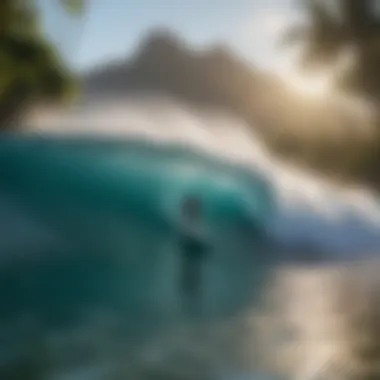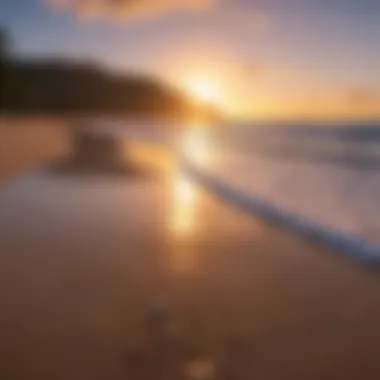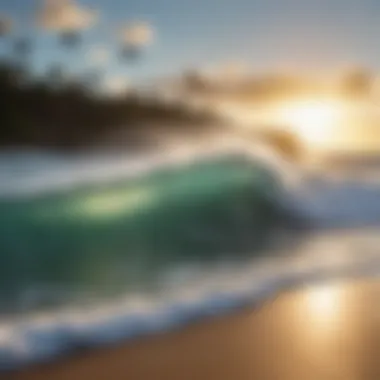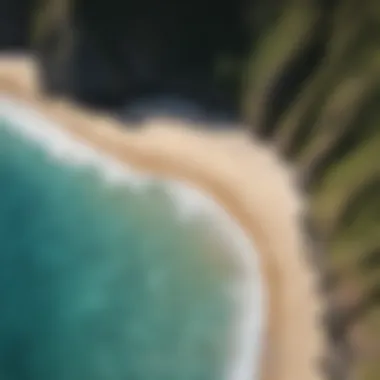Top Surfing Spots in Kauai, Hawaii


Intro
Surfing in Kauai transcends mere recreation; it embodies a rich cultural legacy. The waves here are influenced by local geography and climate. This guide ensures that both seasoned surf veterans and beginners can identify optimal spots, while prioritizing safety and enjoyment.
We will explore not only the key locations but also the requirements for safe surfing, the importance of surfing etiquette, and much more.
Foreword to Surfing in Kauai
The allure of surfing in Kauai is undeniable. Situated on the northernmost edge of the Hawaiian archipelago, the island boasts some of the most stunning surf spots in the world. For enthusiasts—be they thrill-seekers or those just starting—the significance of knowing where to surf in Kauai cannot be overstated. This section aims to provide a deeper understanding of how surfing has evolved on the island and its cultural implications.
Surfing, more than just a sport in Kauai, serves as a cultural beacon. It influences social connections and provides a backdrop for numerous community events. The historical legacy of surfing in Hawaii ties the sport closely to local values and traditions, making it essential for anyone visiting or residing on the island to recognize its milestones. Moreover, appreciation of this contextual framework enhances one’s surfing experience.
Historical Context of Surfing in Hawaii
Surfing has roots reaching back centuries in Hawaiian culture, where it was known as he‘e nalu. Originally, it was a male-dominated activity performed by royalty and warriors, indicative of strength and skill. The sport was not merely recreational; it often occured in ceremonial contexts. Through colonization and subsequent Western influences, surfing saw fluctuations in popularity.
In the early 20th century, figures like Duke Kahanamoku helped revive interest in the sport globally. His reputation as an ambassador for surfing, along with the establishment of surfing schools, played a crucial role in popularizing what was once a sacred practice. The transition from a royal pastime to a communal gathering illustrates the adaptability and resilience of Hawaiian culture.
Cultural Impact of Surfing on Kauai
Surfing is woven into the very fabric of Kauai’s community. Beyond the physical act of riding waves, the sport shapes relationships among residents and visitors alike. Local surf culture emphasizes mutual respect, environmental awareness, and a sense of responsibility among surfers. Engaging with the ocean leads to a deeper appreciation of the natural surroundings, urging surfers to protect the ecosystems that sustain their beloved sport.
Through community gatherings and surfing events, shared experiences strengthen bonds among participants. Events such as competitions often highlight local talent while fostering a sense of camaraderie. This interaction extends beyond mere participation; it encompasses a collective responsibility to support each other within the surfing community.
"Surfing is not just about the waves; it’s also about the connections that we create with each other and our environment."
Understanding the historical and cultural significance of surfing in Kauai is vital for any visitor or resident. This knowledge enriches the experience on the water and emphasizes the need to approach the sport with care and respect.
Climate and Geography of Kauai
Understanding the climate and geography of Kauai is essential for any surfer looking to maximize their experience on this beautiful island. The unique coastal characteristics and weather patterns offer varied surfing conditions throughout the year. This section explores these elements in depth, highlighting how they influence surfing accessibility, wave quality, and overall experience.
Overview of Kauai's Coastal Geography
Kauai's coastal geography plays a significant role in determining surf conditions. The island features a mix of sandy beaches, rocky shorelines, and coral reefs that contribute to diverse wave types. Each of these geographical traits interacts with ocean currents and wind patterns to create specific surfing conditions that can be both challenging and enjoyable.
To illustrate:
- Beaches: Some beaches like Hanalei Bay offer gentle waves ideal for beginners, while others, such as Tunnels Beach, provide more powerful and technical setups for advanced surfers.
- Reefs: The presence of reefs can result in different wave formations. For instance, reef breaks often create sharper, faster waves compared to beach breaks.
Moreover, the island's lush mountains affect local weather patterns, including wind direction and strength. These factors can change conditions rapidly, making it crucial for surfers to remain vigilant and informed about the shifting environment.
Seasonal Weather Patterns Affecting Surfing
Kauai experiences distinct seasonal weather patterns that impact surfing conditions. Waves generally fluctuate between seasons, with winter months (November to March) producing larger swells and summer months (April to October) offering smaller, more manageable waves.
Key seasonal insights include:
- Winter Surf: The North Shore becomes a playground for experienced surfers. Huge swells from the North Pacific create challenging waves, making spots like Hanalei Bay and Tunnels Beach popular among thrill-seekers.
- Summer Surf: The South Shore tends to have more favorable conditions for beginners. Lighter winds and smaller waves at locations such as Poipu Beach provide safe surfing experiences for those still honing their skills.


Considerations when planning surf outings are essential, such as checking swell forecasts and local weather reports, especially since sudden changes can create dangers for unprepared surfers.
“Understanding the interplay of local geography and seasonal weather is key to a safe and enjoyable surfing experience in Kauai.”
Top Surfing Spots on Kauai
Kauai is renowned for its outstanding surfing locations. The variety of beaches attracts surfers of all levels. Each spot offers unique wave conditions, cultural significance, and accessibility options. Detailed knowledge of surfing spots enhances the overall experience for both newcomers and seasoned pros. This section explores five prime surfing locations, diving into their specific characteristics and advantages.
Hanalei Bay
Wave Conditions
Hanalei Bay is a highlight for surfers seeking diverse wave conditions. The bay features powerful waves, particularly during the winter months. Its waves can range from gentle rollers to more challenging surf, accommodating various skill levels. This adaptability makes Hanalei a popular choice. Often, the waves are less crowded than other spots, allowing for a more personal surfing experience. The challenging currents can be a downside, demanding respect and caution.
Accessibility
Accessibility to Hanalei Bay is a notable advantage. It is convenient to reach, with ample parking options nearby. The beach also has facilities, including restrooms and showers. Such amenities enhance the overall comfort for surfers. However, during peak seasons, parking can become scarce. Planning your visit during less busy times can help ease this concern.
Local Surf Culture
The local surf culture at Hanalei Bay is vibrant. It reflects a mix of traditional Hawaiian values and modern surfing. Surfers often engage with one another, fostering a friendly atmosphere. There are also surf schools available for those wishing to learn or improve their skills. However, it is crucial for visitors to respect the local customs and observe etiquette in the water.
Poipu Beach
Wave Characteristics
Poipu Beach features consistent waves that attract many surfers. The surf varies with the seasons, offering something for everyone. Summer usually provides gentler waves, while winter brings more challenging conditions. Surfers appreciate the predictability of the waves, making it a popular choice for many. However, the waves can become crowded, especially on weekends.
Safety Considerations
Safety is paramount at Poipu Beach. Lifeguards are on duty, which adds a layer of security. However, due to strong currents in certain areas, surfers should pay attention to warnings. Cliffs and rocky outcroppings pose risks, particularly for less experienced surfers. Being aware of the rules and safety expectations enhances enjoyment at this beach.
Best Time to Surf
Timing is crucial for surfing success at Poipu Beach. The best conditions often occur during the late morning or early afternoon. This is especially true for beginners, as the surf tends to be gentler then. Conversely, advanced surfers may prefer early mornings, when the swell has built up overnight. Weather patterns can shift, requiring adaptability from surfers.
Tunnels Beach
Technical Difficulty
Tunnels Beach offers a rewarding yet technical surfing experience. The waves here can be challenging and are best suited for intermediate to advanced surfers. The unique reef formations create complex wave structures. Such conditions demand skill and local knowledge. The risk of injury increases due to the surf’s unpredictability. Therefore, novices should approach with caution.
Environmental Awareness
Environmental awareness is a focus at Tunnels Beach. Surfers are encouraged to minimize their impact on local ecosystems. The delicate coral reefs require care, making it essential for visitors to follow guidelines. Being mindful of the environment enhances the appeal of surfing, as it fosters respect for nature. Ignoring these aspects can lead to significant damage to the area.
Visitor Tips
For those visiting Tunnels Beach, preparation is key. Bring adequate safety gear, such as reef boots, to protect against sharp coral. Stay hydrated and consider surf lessons if unsure about local conditions. It is advisable to check local surf reports to understand wave activity. Engaging with local surfers can also provide valuable insights into the best practices.


Kealia Beach
Surfing Conditions
Kealia Beach features consistent, fun waves suitable for various skill levels. The surf breaks both left and right, providing a versatile experience. Seasonal variations can affect wave quality, making surf reports crucial. This beach tends to be less crowded than others, allowing for a more relaxed atmosphere. While enjoyable, the powerful waves can present challenges, especially for inexperienced surfers.
Training Opportunities
Kealia Beach is an excellent spot for training and lessons. Several surf schools operate here, offering instruction for beginners and advanced surfers. This accessibility to coaching makes it easier for newcomers to learn the essentials. However, it can be overwhelming to choose the right training program. Researching options ahead of time ensures a suitable match for individual needs.
Community Interaction
Community interaction at Kealia Beach is a strong feature. The beach often hosts local surf events and gatherings, fostering a sense of camaraderie. Surfers often share tips and advice, enhancing skills. It is a welcoming environment for everyone. Respecting the local surfing community’s culture is vital to maintain goodwill.
Hanapepe Bay
Unique Features
Hanapepe Bay presents unique features appealing to surfers. The bay’s landscape, combined with varying wave conditions, attracts many enthusiasts. The picturesque scenery provides an enchanting backdrop for surfing. Crowds are generally lighter here, making for a more intimate experience. However, the waves may not be as consistent as more popular spots, impacting some surfers’ enjoyment.
Competitions and Events
The bay occasionally hosts surfing competitions, drawing participants from all over. These events showcase local talent and offer opportunities for exposure. Spectators enjoy a thrilling display of skill and athleticism. However, during events, the beach can become crowded, impacting the overall surfing experience. Planning a visit around such events can be beneficial for exposure to local talent.
Local Surfer Perspectives
Local surfers provide valuable insights into Hanapepe Bay’s best practices. Engaging with the community can enrich a visitor’s experience. They can share information about peak conditions and safety considerations. However, visitors should approach locals respectfully and remain open to feedback. Understanding local etiquette enhances the experience significantly.
Surfing for Different Skill Levels
Kauai offers diverse surfing experiences, catering to all skill levels. Understanding these differences is essential for both beginners and advanced surfers alike. Each surf spot on the island presents its own set of challenges and rewards, from gentle lessons on forgiving waves to adrenaline-pumping rides for seasoned surfers. This section explores how to navigate your skill level in Kauai’s unique surfing environment while highlighting critical considerations.
Beginner-Friendly Locations
Recommended Lessons
For those new to surfing, taking lessons is crucial. Surfing lessons provide foundational skills that enhance safety and enjoyment. The key characteristic of recommended lessons is their structured approach. Instructors often emphasize proper techniques, ocean awareness, and etiquette, laying a solid groundwork for new surfers. Companies like Kauai Surf School offer tailored group and private lessons that emphasize progression. The unique advantage of optimized lessons is that they combine instructional time with actual wave riding experience, allowing beginner surfers to gain confidence efficiently.
Equipment for Beginners
Selecting the right equipment is paramount, especially for beginners. A beginner’s surfboard is typically larger and more stable compared to advanced boards, providing a better platform for learning. Boards made of soft materials are safer, minimizing injury risks. Soft-top surfboards are particularly beneficial; they are buoyant and forgiving, making it easier to paddle and catch waves. However, beginners should consider the weight of the board as lighter boards can sometimes be more maneuverable. Having the correct leash and wetsuit is also important for overall comfort and safety, as this gear adapts to the varying weather conditions in Kauai.
Advanced Surfing Challenges
Complex Wave Structures
For experienced surfers, Kauai doesn’t disappoint with its complex wave structures. These waves can vary significantly in power and form, offering thrilling challenges. The unique feature of complex wave structures lies in their unpredictability. Surfers must adapt to changes in both wave height and behavior. The challenge can be rewarding, as navigating through such conditions can enhance a surfer's skills. However, it's essential to understand the local ocean conditions and timings before attempting these waves, as they can be harsh and unforgiving.
Local Knowledge Requirements


Having local knowledge is an invaluable asset for advanced surfers. Understanding the conditions of different surf spots is crucial for making informed decisions. Local surfers possess insights on tides, prevailing winds, and even hidden dangers, which significantly affect surfing experiences. For instance, being aware of any reef breaks or shifting currents can mean the difference between an exhilarating ride and a hazardous situation. Engaging with local surf reports or participating in community forums on reddit.com can provide up-to-date information that enhances your surfing experience, ensuring safety while tackling the more challenging waves.
The mastery of surfing in Kauai relies heavily on respecting the ocean, embracing its variability, and keeping safety in mind at all times.
Environmental Considerations
The relationship between surfing and the environment is complex. For a sport that thrives on the natural elements, it is essential to consider how surfing affects local ecosystems. Understanding the environmental implications of surfing not only serves to protect these vital areas but also enhances the overall surfing experience.
Impact of Surfing on Local Ecosystems
Surfing can exert considerable pressure on coastal ecosystems. The presence of surfers on beaches and in the water can lead to various forms of degradation.
- Physical Disturbance: Recreational activities, including surfing, can disrupt marine life, particularly during breeding seasons. The paddling and movement of surfers can disturb nesting areas for sea turtles and other wildlife.
- Pollution: Waste generated by surfers, such as plastic bottles, food wrappers, or waxing products, can contribute to pollution. If these items are not disposed of properly, they can harm marine life and degrade water quality.
- Coral Damage: Many surf spots are near sensitive coral reefs. Surfers who do not practice caution can unintentionally damage these delicate structures, which serve as critical habitats for numerous marine species. Studies have shown that increased surfing activity can lead to significant coral reef degradation.
Adverse effects include:
- Loss of biodiversity
- Alteration of natural habitats
- Disruption of the food chain
Awareness of these issues is vital. Through education and advocacy, surfers can learn to minimize their impact, ensuring that these ecosystems remain healthy.
Sustainability Practices in Surfing Communities
Many surfing communities recognize the imperative of sustainability. Initiatives aimed at reducing harmful effects on the environment are on the rise, emphasizing the importance of conscious choices.
- Beach Cleanups: Local surfer organizations frequently organize clean-up events. These efforts not only help in maintaining the beaches but also inspire a culture of responsibility among surfers.
- Eco-Friendly Equipment: Some brands are developing surfboards made from sustainable materials, like recycled EPS foam. These boards can help reduce the ecological footprint of surfing.
- Advocating for Policies: Surfing communities are often at the forefront of environmental advocacy, pushing for policies that protect coastal areas and marine environments.
"As surfers, we must be stewards of the oceans we love. Protecting our waves is protecting our way of life."
Through fostering awareness and implementing these practices, the surfing community can mitigate its impact on local ecosystems. An informed and engaged surfing population can ensure that the beautiful waters off Kauai remain vibrant and accessible for future generations.
Culmination and Recommendations
In this article, we have explored the myriad of surfing options Kauai offers. The conclusion is important as it synthesizes these insights into practical recommendations for surfers of all skill levels. Understanding the diverse surfing landscape not only enhances the experience but also fosters a deeper appreciation for the culture and environment surrounding this beloved sport.
When considering places to surf in Kauai, one should evaluate key aspects such as wave conditions, accessibility, and local safety protocols. Each beach has its own character, shaped by geography and ocean dynamics. This impacts not only the surfing grade but also the experience of being part of the local surfing community.
In recommending locations, it’s vital to match surfers with surf spots that match their competencies. Beginner surfers, like those wanting to learn or improve their technique, should gravitate toward more forgiving waves. Advanced surfers might seek out challenging spots, which require not only skill but also a connection to the local surf culture.
Engagement with these communities can enhance one's surfing adventure. Local knowledge can offer insights about occasions and relevant safety guidelines. Additionally, understanding cultural traditions associated with surfing in Kauai is crucial. Respecting the ocean and the land is a value instilled in local practices.
As one prepares for their voyage to Kauai's shores, they should equip themselves with adequate gear and knowledge. Consider local surf schools, as many offer tailored lessons even for the more seasoned surfer wanting to learn specifics about Kauai's unique environments.
Summary of Key Insights
Throughout our exploration of Kauai's surf locations, several key insights emerge:
- Diverse Locations: Kauai features a range of surfing spots, each offering distinct wave profiles and environments.
- Skill Considerations: It's essential to choose your surfing location based on your skill level to ensure a safe experience.
- Cultural Importance: Surfing in Kauai is more than a sport; it carries significant cultural weight.
- Community Engagement: Seeking guidance from local surfers can maximize the surfing experience and increase enjoyment.
- Environmental Responsibility: Protecting the local ecosystem should be a priority for all surfers.
Future Trends in Kauai Surfing
The landscape of surfing in Kauai is ever-evolving. Numerous trends shape the future of this vibrant sport:
- Sustainability Practices: There's a growing emphasis on protecting marine ecosystems. Surfers are becoming more aware of their impact and seeking to minimize it.
- Technology Integration: Smart equipment and apps tailored to surfing might enhance safety and track conditions.
- Surfer Diversity: As the sport gains popularity, the diversity of surfers is broadening, introducing varied perspectives on cultural practices and requirements.
- Competitive Surfing Events: Increased focus on events showcases the talents of local surfers while promoting the region as a premier surfing destination.
The future of Kauai surfing promises to be dynamic, deeply rooted in tradition while adapting to modernity. Engaging with this culture now allows both seasoned and novice surfers to contribute positively to the environment and community.





